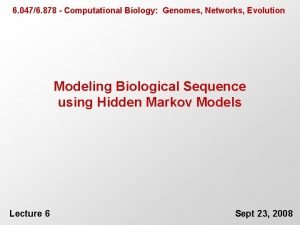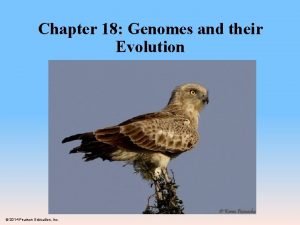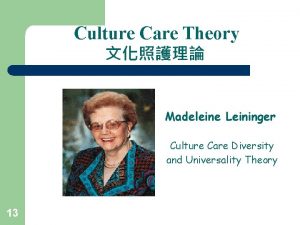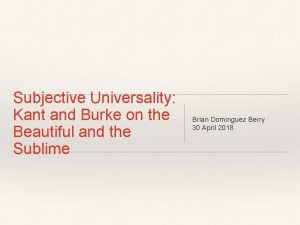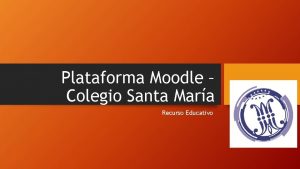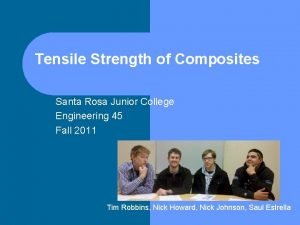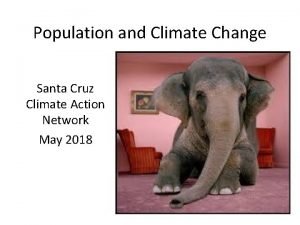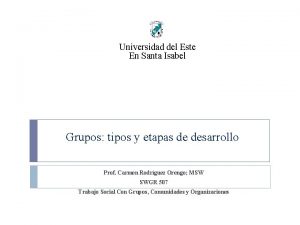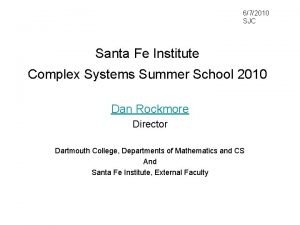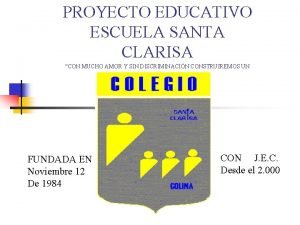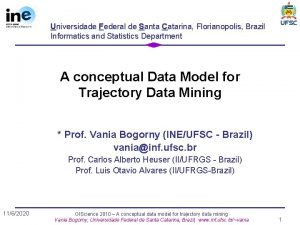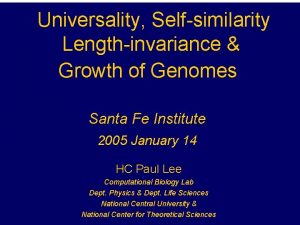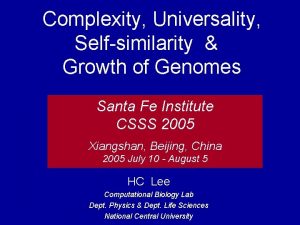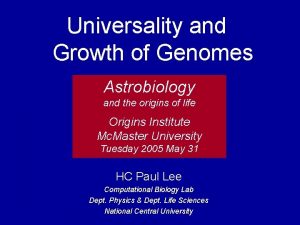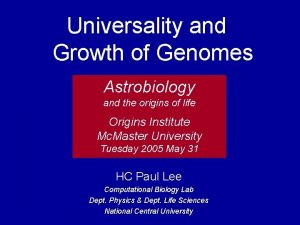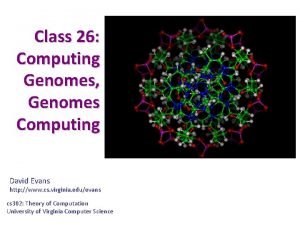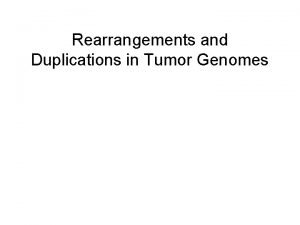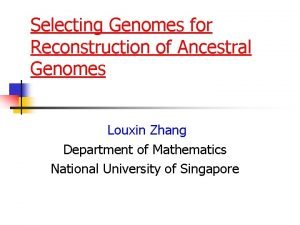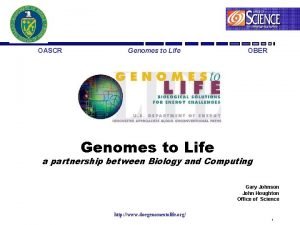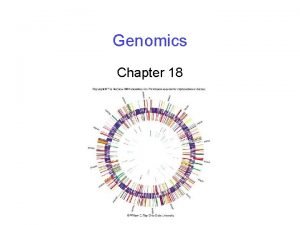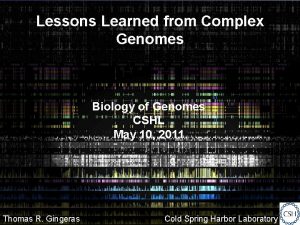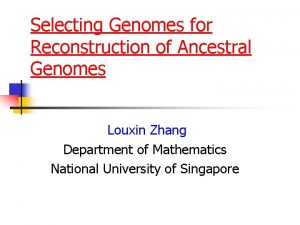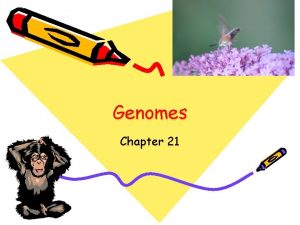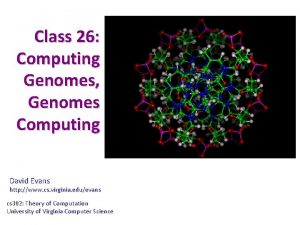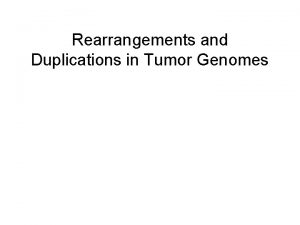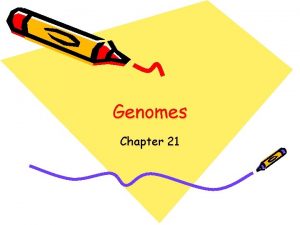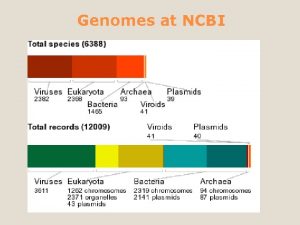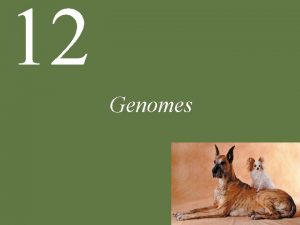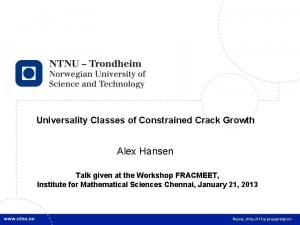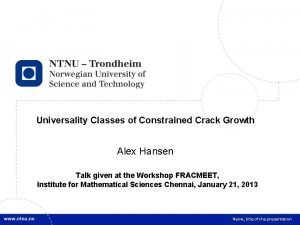Universality Selfsimilarity Lengthinvariance Growth of Genomes Santa Fe
























![c 2 = <[((Lr)model – (Lr)gen)/D (Lr)gen]2> Model parameter search: favors very small L c 2 = <[((Lr)model – (Lr)gen)/D (Lr)gen]2> Model parameter search: favors very small L](https://slidetodoc.com/presentation_image_h/338bc5679ff6b5b6109fbe7e0f9a8504/image-25.jpg)





























- Slides: 54

Universality, Self-similarity Length-invariance & Growth of Genomes Santa Fe Institute 2005 January 14 HC Paul Lee Computational Biology Lab Dept. Physics & Dept. Life Sciences National Central University & National Center for Theoretical Sciences

Life is highly diverse and complex We are here

And it took a long time to get here now 4 billion yrs ago

Evolution of Genomes and the Second Law of Thermodynamics • Genomes grew & evolved stochastically • modulated by natural selection • Bigger genomes carry more information than smaller ones • The second law of thermodynamics: • the entropy of closed system can never decrease • a system that grows stochastically tends to acquire entropy • Increased randomness more entropy • Shannon information • Information decreases with increasing entropy

21 century random text generator - Courtesy PY Lai

How did evolution fight against the Second Law? • Genomes are not closed systems, but the 2 nd law does make it difficult for the genome to simultaneously: • grow stochastically • acquire more information • lose entropy • gain order • How did genomes acquire so much information in such a short time?

http: //www. ncbi. nlm. nih. gov/PMGifs/Genomes/micr. html

Genomes are BIG A stretch of genome from the X chromosome of Homo sapien http: // www. ncbi. nlm. nih. gov/ entrez/viewer. fcgi? val =2276452&db =Nucleotide &dopt =Gen. Bank The complete genome has 2, 000 such Pages 1 tgctgagaaa acatcaagctg tgtttctcct tccccaaag acacttcgca gcccctcttg 61 ggatccagcgcaagg taagccagat gcctctgctg ttgccctccc tgtgggcctg 121 ctctcctcac gccggccccc acctgggcca cctgtggcac ctgccaggag gctgagctgc 181 aaaccccaat gaggggcagg tgctcccgga gacctgcttc ccacacgccc atcgttctgc 241 ccccggcttt gagttctccc aggcccctct gtgcacccctagcagg aacatgccgt 301 ctgccccctt gagctttgca aggtctcggt gataatagga aggtctttgc cttgcaggga 361 gaatgagtca tccgtgctccgagggg gattctggag tccacagtaa ttgcagggct 421 gacactctgc cctgcaccgg gcgccccagc tcctccccac ctcctc catccctgtc 481 tccggctatt aagacggggc gctcaggggc ctgtaactgg ggaaggtata cccgccctgc 541 agaggtggac cctgtt ttgatttctg ttccatgtcc aaggcaggac atgaccctgt 601 tttggaatgc tgatttatgg attttccagg ccactgtgcc ccagatacaa ttttctctga 661 cattaagaat acgtagagaa ctaaatgcat tttcttctta aaaaa aaaccaaaaa 721 aaaaa aaaccaaaaa actgtactta ataagatcca tgcctataag acaaaggaac 781 acctcttgtc atatatgtgg gacctcgggc agcgtgtgaa agtttacttg cagtttgcag 841 taaaatgaca aagctaacac ctggcgtgga caatcttacc tagctatgct ctccaaaatg 901 tattttttct aatctgggca acaatggtgc catctcggtt cactgcaacc tccgcttccc 961 aggttcaagc gattctccgg cctcagcctc ccaagtagct gggaggacag gcacccgcca 1021 tgatgcccgg ttaatttttg tatttttagc agagatgggt tttcgccatg ttggccaggc 1081 tggtctcgaa ctcctgacct caggtgatcc gccttg gcctcccaaa gtgctgggat 1141 gacaggcgtg agccaccgcg cccagg aatctatgca tttgcctttg aatattagcc 1201 tccactgccc catcagcaaa aggcaaaaca ggttaccagc ctcccgccac ccctgaagaa 1261 taattgtgaa aaaatgtgga attagcaaca tgttggcagg atttttgctg aggttataag 1321 ccacttcctt catctgggtc tgagcttttt tgtattcggt cttaccattc gttggttctg 1381 tagttcatgt ttcaaaaatg cagcctcaga gactgcaagc cgctgagtca aatacaaata 1441 gatttttaaa gtgtatttat tttaaacaaa aaataaaatc acacataaga taaaacaaaa 1501 cgaaactgac tttatacagt aaaataaacg atgcctgggc acagtggctc acgcctgtca

Genome as text Frequencies of k-mers • Genome is a text of four letters – A, C, G, T • Frequencies of k-mers characterize the whole genome – E. g. counting frequencies of 7 -mers with a “sliding window” – Frequency set {fi |i=1 to 4 k} N(GTTACCC) = N(GTTACCC) +1

Frequency set, k-spectrum & relative spectral width Given freq. set {fi }, define ----- f = G/2 Relative spectral width = std dev/<f> nf (Number of 6 -mers) k-spectrum {nf|f=1, 2, …} i f i = n f nf Example: 6 -spectrum of B. subtilis Width (2 x Std. Deviation) Mean frequency G f f (Frequency of 6 -mers)

Huge difference between genomes and random sequences Black: genome of E. coli Green: matching random sequence Detail of “m=2” set (Red: model sequence) 50/50 70/30

5 -spectra of “genomes” with different base compositions Green – random Black – genome Orange - model 70/30 60/40 50/50

Shannon entropy • Shannon entropy for a system frequency set {fi| i fi=L} or a spectrum {nf} is H = - i fi/L log (fi/L)= - f nf f/L log (f/L) • Suppose there are types of events: i = . Then H has maximum value when every fi is equal to N/ : Hmax = log • For a genomic k-frequency set: =4 k, L = genome length. Hmax=2 k log 2

Shannon information & relative spectral width • Information decrease with increasing H: define Divergence D = log – H = f nf f/L log (f/fave) • Related to relative spectral width squared (for unimodal distribution) = /2 f D = 2/2 - ( 3 3/6 + ( 4/12 - … • For multimodal distributions, define Shannon information as R = weighed average of D over modes

R = log - H is a good definition Sequences have AT/CG= 50/50 --------------- Rgen/Rran -------- 4500 1922 728 246 94 29 10 3. 0 - ---------------

Fractional (A+T) content p Complete Genomes are diverse PF: Plasmodium falciparum (A eukaryotic Malaria causing parasite) Sequence length L (bases)

Measurements • Measure (by computation) - reduced spectral widths M - reduced Shannon information MR - k-spectra, k = 2 to 10 - 282 complete sequences (155 microbial genomes and 127 eukaryotic chromosomes) • Results - M ~ MR - Plot M versus L, sequence length

Reduced Shannon information Results: color coded by organisms Each point from one k-spectrum of one sequence; >2500 data points. Black crosses are microbials. Data shifted by factor 210 -k.

Reduced Shannon information Color coded by k: Narrow k-bands Data from 14 Plasmodium chromosomes excluded; ~2400 data points. For each k, 268 data points form a narrow Ms ~ L “k band”.

Genomic Shannon information not relative to random sequence is length invariant k 10 9 8 7 6 5 4 3 2 SIrandom k=10 SIrandom k=2 (x 100)

Genomes are in Universality Classes • Each k-band defines a universal constant L/M ~ constant = Lr (Effective root-sequence length) • Obeys log Lr(k) = a k + B 1989 pieces of data given be two parameters. a = 0. 398+-0. 038 B = 1. 61+- 0. 11 • Defines a universal class • Plasmodium has separate class: a = 0. 146+-0. 012 Black: genome data; green: artificial

Replica & universal root-sequence length • Take random root-sequence of length Lr and replicate to length L of some genome, then full sequence will have MR = L/Lr (for any k) • Or, any sequences obtained by replication of the root-sequence (i. e. a replica) will have L/MR = Lr • A set of replicas of variable lengths all replicated from (not necessarily the same) random rootsequences of length Lr will have k-independent universal L/MR = Lr

RSI in an m-replica is multiplied m times (A) Random “matches” of 155 microbial genomes; k=2 -10 (B) 100 -replica matches of 155 microbial genomes; k=2 -10

A Hypothesis for Genome Growth • Random early growth – Random b/c has no information • Followed by 1. random segmental duplication and 2. random mutation Self copying – strategy for retaining and multiple usage of hard-to-come-by coded sequences (i. e. genes)
![c 2 Lrmodel LrgenD Lrgen2 Model parameter search favors very small L c 2 = <[((Lr)model – (Lr)gen)/D (Lr)gen]2> Model parameter search: favors very small L](https://slidetodoc.com/presentation_image_h/338bc5679ff6b5b6109fbe7e0f9a8504/image-25.jpg)
c 2 = <[((Lr)model – (Lr)gen)/D (Lr)gen]2> Model parameter search: favors very small L 0

Maximally stochastic segmental duplication model works Reduced Shannon information Reduced spectral width Red & blue symbols are from (same) model sequences

Are genomes self similar? • Very small Leff suggests genomes has very high duplication content • Our model based on maximally stochastic segmental duplication reproduce empirical kspectra and Leff • If genomes are sufficiently uniform, then genome should exhibit whole-genome property on a scale of ~Leff – i. e. for any segment of length l, should have M (k)/l ~ (RSW of whole genome)/L~ Leff (k)

Two examples: H. sapien and E. coli: genomes are highly self-similar

Lu and Ld, k=5, all complete sequences

Average Lu and Ld versus k

Genomes are maximally self-similar • Lsim is the average of prokaryotic Lu & Ld & eukaryotic Ld k • Lsim barely > Lr barely > 4 , • Hence genomes are almost maximally self-similar

Model Lsim agrees with data Note: Model predates data But model has smaller spread Model is too smooth

Word Intervals • Intervals (spatial or temporal) between adjacent random uncorrelated events have an exponential distribution • In a random sequence, intervals of identical words are exponential • What is the word-interval distribution in a (nonrandom) genome?

random sequence Interval distribution is exponential in random sequence as expected. But also in genome! genome model sequence And in the model sequence (not surprising, because growth mechanism is maximally stochastic).

Words are randomly placed in genomes 41 microbial genomes longer than 4 Mb m=a A from exponential Fit; is average d from sequence. genomes Conclusion: words are randomly generated in genomes. Emulated by growth model sequences

Substitution and duplication rates • Identify substitutions and duplications by sequence similarity (“blasting”) • Substitution rate – K: substitution per site between two homologous sequences – T: divergence time of two sequences – Subst. rate r. S = K/2 T (/site/unit time) • Duplication rate – N: number of duplication events per site – Duplication rate r. D = N/T (/site/unit time)

Some data on rates from human • Data – Estimated silent site substitute rates for plants and animals range from 1 to 16 (/site/By) (Li 97) – Humans: r_S ~2 (Lynch 00) or 1 (Liu 03) /site/By. – Animal gene duplication rate ~ 0. 01 (0. 002 to 0. 02) per gene per My (Lynch 00) – Human (coding region ~ 3% of genome) translates to 3. 9/Mb/My. – Human retrotransposition event rate ~ 2. 8/Mb/My (Liu 03) • Estimate rates for human r. S ~ 2 /site/By, r. D ~ 3. 4/Mb/My • Human genome grew 15 -20% last 50 My (Liu 03) • References – Lynch & Conery Science 290 (2000) – Liu (& Eichler) et al. Genome Res. 13 (2003)

Rates from growth model • Arguments – Can estimate substitution and duplication rate if assign total growth time – Human genome still growing last 50 My – Hence assume total growth time for human genome T ~ 4 By • Get rates average over T <r. S> ~ 0. 25/site/By, <r. D> ~ 0. 50/Mb/My • About 7~8 time smaller than recent sequence divergence estimates

Bridging the two estimates • Rates are per length; hence lower when genome is shorter • Sequence divergence rates r. S, D for last DT~50 My are terminal rates • Model rates <r. S, D> averaged over whole growth history, hence <r. S, D> less than r. S, D • Assume constant (intrinsic) rate rc and genome grew exponentially with time L(t)= L 0 exp(T/ )

Rates and growth estimates are consistent with other sources • Very roughly, constant rates in human – site substitution: r. S ~ 2 /site/By, – segmental duplication r. D ~ 3. 4/Mb/My, • Growth – L(t) ~ 0. 001 (Bb) L 0 exp(t/0. 5 (By) ) • Remarks – – grew by ~ 12% last 50 My Liu et al. grew by ~ 15 -19% last 50 My Does not imply L=1 Mb at t=0 Does imply at t << 500 My, L ~ 1 Mb

Closer look at Plasmodium p-dependence of Lr Plasmodium <Rgen/Rran> was computed as weighted average over ratio of m-sets. Exhibits pdependence that exagerates specialness of Plasmodium.

Plasmodium may be accommodated in main class Anomaly of Plasmodium reduced when ratio of weighed averages taken. (Anomalous k=10 data near p=0. 6 from very short genomes of E. cuniculi. Plasmodium <Rgen>/<Rran>

Summary of results • Shannon information reveal universal lengths in genomes; genomes belong to universality class • Clear footprint of evolution • Data consistent with: genome grew by maximally stochastic segmental duplication plus random point mutation • Genomes highly self-similar and has high degree of randomness • For human genome, site substitution and segmental duplication rates consistent w/ those extracted by sequence divergence methods

Shannon information versus biological information • Large Shannon information is necessary condition for rich biological information • Growth by random duplication provides an basis allowing natural selection to fine-tune, via natural selection, Shannon information into biological information • The adaptation of the strategy of growth by random duplication by itself may be a consequence of natural selection

Neutrality vs Natural selection • Growth by maximal stochastic segmental duplication implies neutrality is the main mode for genome growth • If there is biological information in a genome to begin with, then random segmental duplication is the most parsimonious, hence fastest, way to accumulate information • During early growth, it would be extremely difficult and slow to generate new information and maintain constant relative spectral width by natural selection mutation, (non-duplicative) insertion and deletion

The RNA world • Because our analysis suggests growth by random duplication began when genome was not longer than 300 bases, it supports an early RNA world • A genome ~300 b or less can code a number of small ribozymes (hammerhead is only 31 nt), but is too short to code for a single enzyme • Spontaneous formation of small ribozymes have been demonstrated in vitro

Are genes “spandrels”? • Spandrels – In architecture. The roughly triangular space between an arch, a wall and the ceiling – In evolution. Major category of important evolutionary features that were originally side effects and did not arise as adaptations (Gould and Lewontin 1979) • The duplications may be what the arches, walls and ceilings are to spandrels and the genes are the decorations in the spandrels

Classical Darwinian Gradualism or Punctuated Equilibrium? • Great debated in palaeontology and evolution Dawkins & others vs. (the late) Gould & Eldridge: evolution went gradually and evenly vs. by stochastic bursts with intervals of stasis Our model provides genetic basis for both. Mutation and small duplication induce gradual change; occasional large duplication can induce abrupt and seemingly discontinuous change

Growth by duplication may provide partial answers to: • How did life evolve so rapidly? • How have genes been duplicated at the high rate of about 1% per gene per million years? (Lynch 2000) • Why are there so many duplicate genes in all life forms? (Maynard 1998, Otto & Yong 2001) • The chromosome exchanges that characterize mammalian and plant radiations. (O’Brien et al. 1999; Grant, et al. 2000) • Was duplicate genes selected because they contribute to genetic robustness? (Gu et al. 2003) – Likely not; Most likely high frequency of occurrence duplicate genes is a spandrel

Some references • Model for growth of bacterial genomes, LS Hsieh and HCL, Mod. Phys. Lett. 16 (2002) 821 -827 • Minimal model for genome evolution and growth, LC Hsieh et al. , Phys. Rev. Letts. 90 (2003) 018101 -104 • Universality in large-scale structure of complete genomes, LS Hsieh et al. , Genome Biology, 5 (2004) 7 • Universal lengths in complete microbial genomes, TY Chen et al. Int. J. Mod. Phys. B 18 (2004) • Shannon information in complete genomes, CH Chang, et al. , IEEE Proc. Computer Sys. Bioinfomatics (CSB 2004) 20 -30; J. Bioinfo. & Comp. Biology (to appear Mar. 2005) • Shannon Information and Self-Similarity in Complete Genomes, TY Chen et al. , Comp. Phys. Comm. (to appear 2005) • For copies, see website of HCL: “Google”: HC Lee

Computation Biology Laboratory (2003) 謝 Hsieh立 青 陳 大 Chen 元 范 WL Fan 文 郎 張 Chang 昌 衡

Shannon Information in Complete Genomes CSB 2004, August 17 -19, Stanford HC Lee Computational Biology Lab Dept. Physics & Dept. Life Sciences National Central University & National Center for Theoretical Sciences

Complexity, Universality and Growth of Genomes International Workshop on Computational Physics NCHC, Shinchu, 2004 Dec. 2 -4 HC Lee Computational Biology Lab Dept. Physics & Dept. Life Sciences National Central University & National Center for Theoretical Sciences

Complexity, Universality and Growth of Genomes 2004 Taipei Winter Workshop on Biological & Nonlinear Physics NTU, Taipei, 2004 Dec. 17 -18 HC Lee Computational Biology Lab Dept. Physics & Dept. Life Sciences National Central University & National Center for Theoretical Sciences
 Computational biology: genomes, networks, evolution
Computational biology: genomes, networks, evolution Chapter 18 genomes and their evolution
Chapter 18 genomes and their evolution Theory of culture care diversity and universality
Theory of culture care diversity and universality Subjective universality
Subjective universality Santa apolonia santa rosa
Santa apolonia santa rosa Primary growth and secondary growth in plants
Primary growth and secondary growth in plants Organic growth vs inorganic growth
Organic growth vs inorganic growth Relative growth rates
Relative growth rates Vascular ray
Vascular ray Shoot system
Shoot system Geometric exponential growth
Geometric exponential growth Carothers equation
Carothers equation Neoclassical growth theory vs. endogenous growth theory
Neoclassical growth theory vs. endogenous growth theory Santa cruz community counseling
Santa cruz community counseling Moodle santa maria
Moodle santa maria Tap plastics santa rosa
Tap plastics santa rosa Santa cruz climate action network
Santa cruz climate action network What does santa carry the toys in
What does santa carry the toys in Jason hajduk
Jason hajduk Clara abbott scholarship
Clara abbott scholarship Santa barbara county selpa
Santa barbara county selpa Certificado catastral santa fe
Certificado catastral santa fe Don guanella bari chiesa
Don guanella bari chiesa Bajo tu amparo nos acogemos oracion
Bajo tu amparo nos acogemos oracion Semana santa slides
Semana santa slides Glc consultoria
Glc consultoria Universidad del este santa isabel
Universidad del este santa isabel Santa cruz de san saba map
Santa cruz de san saba map Stan posey nvidia
Stan posey nvidia Santa fe institute summer school
Santa fe institute summer school Aceite de la santa uncion exodo 30 22-33
Aceite de la santa uncion exodo 30 22-33 Aula virtual santa clara de asis
Aula virtual santa clara de asis Torca santa monica
Torca santa monica Santa monica college honors program
Santa monica college honors program Imagem santa ceia leonardo da vinci
Imagem santa ceia leonardo da vinci La ruota della messa
La ruota della messa Fundaciones de santa teresa
Fundaciones de santa teresa Colegio santa clarisa colina
Colegio santa clarisa colina Frases de santa rosa de viterbo
Frases de santa rosa de viterbo Abside de santa eulalia de estaon
Abside de santa eulalia de estaon Xkcd santa
Xkcd santa Santa monica housing authority
Santa monica housing authority What do children hang up for santa to put the toys in
What do children hang up for santa to put the toys in Santa sofia ubicacion
Santa sofia ubicacion Santa costanza
Santa costanza Off the grid alameda
Off the grid alameda Cpcc transcript
Cpcc transcript Santa ana college plan c
Santa ana college plan c San lucas 14 15-24
San lucas 14 15-24 Academia santa rosa de lima
Academia santa rosa de lima Escuela santa rosa de chena
Escuela santa rosa de chena Santa tecia
Santa tecia Que muero porque no muero
Que muero porque no muero Amata ferri
Amata ferri Universidade federal de santa catarina brazil
Universidade federal de santa catarina brazil
